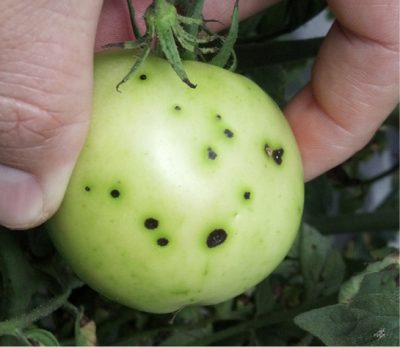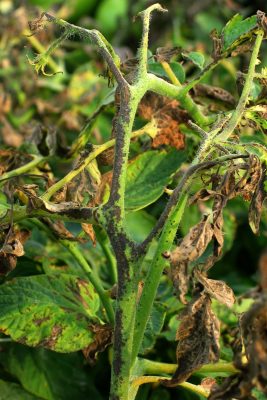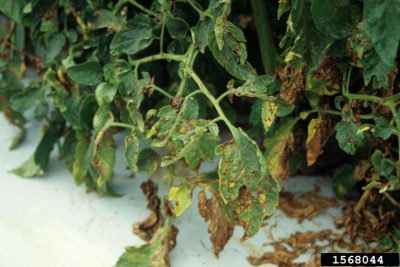Bacterial speck and bacterial spot are two similar diseases of tomato that are common in our region. Both cause crop loss and reduction in fruit quality, and both are much easier to prevent than to control.
Bacterial speck is caused by Pseudomonas syringae pv. tomato. It primarily affects tomato and a number of weeds, and is the most common disease of tomato that is caused by a bacterial pathogen. The disease is favored by low temperatures (55 to 77°F) and high moisture.
Bacterial spot is caused by Xanthomonas campestris pv. vesicatora. It causes spots on the leaves and fruit of tomato, pepper, black nightshade, and ground cherry. This disease is favored by warmer temperatures (75 to 86°F) and high moisture.
Bacterial speck symptoms
Small, superficial black specks or lesions appear on fruit infected with bacterial speck. These specks are less than 1/16″ in diameter, slightly raised and have a distinct margin. As the fruit grows, the specks often will become sunken into pits, since the healthy tissue grows faster than the lesions. The tissue around the specks often remains green longer than the rest of the ripening fruit. The largest specks often appear on the smallest fruits, since immature green fruit is more susceptible to infection.

Bacterial speck can also cause foliar spots. Leaf spots are round and dark brown to black. A light-colored ring may appear around the spots once the spots are older. The spot goes all the way through the leaf, and is most visible on the bottom of the leaf. Often, several nearby spots will coalesce and form larger necrotic areas on leaves. When this happens on young leaves, the tissue between the spots tears as the leaf grows. Spots on the petioles and stems are dark brown to black and oval to elongated. Spots can appear on all aboveground parts of the plant, except the petals.

Bacterial spot symptoms
Bacterial spot symptoms on leaves are greatly affected by moisture levels. Under moderate moisture, leaves have small (less than 1/8″), round and black spots. The upper surface may be somewhat greasy and translucent with a black margin. The center, translucent tissue will soon dry and appear very thin, and may crack. The spots will often be more numerous on younger leaves and may occur on only one or two leaflets on any given leaf. Under conditions of heavy moisture, the leaves will look blighted rather than spotted. The margins and the areas between the veins will yellow, and will later become water-soaked and greasy looking. Many small spots are usually present, and these may grow together. The leaf will eventually die. If seedlings are severely spotted, the leaves may turn yellow and drop.

Spots on fruit begin as dark raised spots surrounded by a water-soaked border. As the fruit expands, the spots may appear to be sunken in pits, as the healthy tissue will grow faster than the spotted tissue. Older spots may reach a diameter of 1/3″ and are black, slightly raised and have lobed borders. They do not penetrate the seed cavity of the fruit, but instead are superficial. As they age, the centers of the spots disintegrate and sink, and eventually form a crater. The skin of the fruit is often cracked at the edge of older spots. The water-soaked border is absent for older spots.

Differentiating bacterial speck and spot. The two diseases can be differentiated in several ways. Bacterial spot causes larger fruit spots. The leaf spots for bacterial spot are round to angular, while those for bacterial speck are only round. For a definite diagnosis, place a piece of diseased tissue in a drop of water under a microscope. Bacterial speck bacteria ooze out of the tissue in a semi-gelatinous mass, while bacterial spot bacteria ooze out freely.
Look-alike diseases. Bacterial speck and spot might be confused with other common diseases. Early blight leaf spots are generally larger (1/2″), have a target appearance, and may have a light-colored ring around each spot. Early blight causes large target-like spots near the stem of green or ripe fruit. Septoria leaf spots are circular, brown to greyish, and often have tiny black dots in them. Septoria does not cause fruit spots.
Disease Management
- Plant resistant varieties.
- Use certified disease-free seeds and transplants. Monitor transplants closely for symptoms prior to transplanting.
- Hot water treatment of seeds can be very helpful, as well. [https://plant.lab.uconn.edu/hwst/]link to HWST
- Clean and disinfect greenhouse benches and trays and other materials that are being re-used.
- Mulching with plastic or straw minimizes the splashing of contaminated soil on to the plants.
- Avoid overhead irrigation. When irrigating, do it early in the day to allow the plants to dry before night. Drip tape would be preferred.
- Trellising will improve airflow and expediting foliage drying.
- Avoid working the fields when wet.
- Control weeds and tomato volunteers.
- For bacterial speck, use a crop rotation of at least one year.
- For bacterial spot, use a 2- to 3-year crop rotation without peppers or wheat.
- Keep cull piles away from production areas.
- Plow under debris or remove from field.
- See current reccomendations for chemical control measures.
References:
McGrath, M. (2023). Bacterial speck of tomato. Vegetable Pathology – Long Island Horticultural Research & Extension Center. https://blogs.cornell.edu/livegpath/gallery/tomato/bacterial-speck-of-tomato/
Schuh, M., Johnson, A., Grabowski, M., & Orshinsky, A. (2021). Bacterial spot of tomato and pepper. University of Minnesota Extension. https://extension.umn.edu/disease-management/bacterial-spot-tomato-and-pepper#monitoring-for-bacterial-spot-3031210
Published in October 2023.
This article is updated by Maggie Ng and Shuresh Ghimire from an original one by Pam Mercure and Jude Boucher first published in 2012.
UConn Extension Vegetable IPM Team.
Information on our site was developed for conditions in the Northeast. Use in other geographical areas may be inappropriate.
The information in this document is for educational purposes only. The recommendations contained are based on the best available knowledge at the time of publication. Any reference to commercial products, trade or brand names is for information only, and no endorsement or approval is intended. The Cooperative Extension System does not guarantee or warrant the standard of any product referenced or imply approval of the product to the exclusion of others which also may be available. The University of Connecticut, Cooperative Extension System, College of Agriculture and Natural Resources is an equal opportunity program provider and employer.